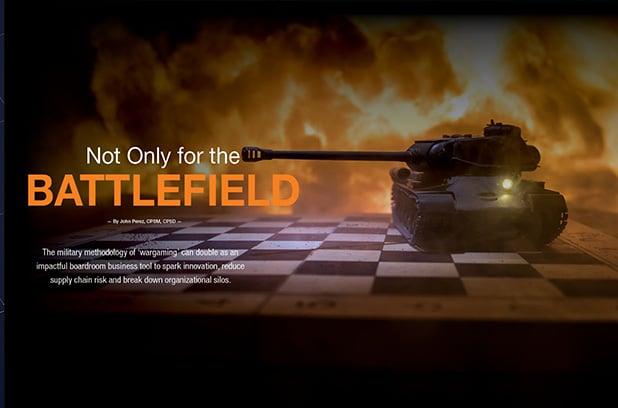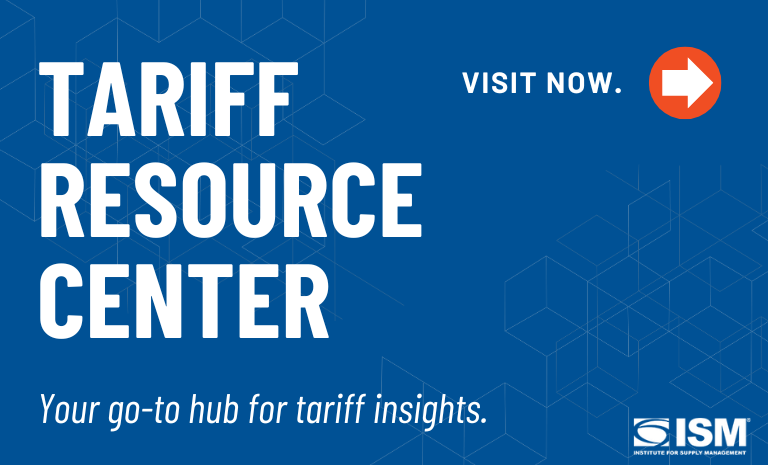Not Only for the Battlefield
The military methodology of ‘wargaming’ can double as an impactful boardroom business tool to spark innovation, reduce supply chain risk and break down organizational silos.

For more than 200 years, military strategists have enthusiastically incorporated “wargaming” into their strategy development arsenal. But it’s no longer only a ubiquitous methodology for strategy development used by armed forces across the world.
It has become a powerful tool for supply managers and other professionals across industries and functions, in both the public and private sector.
As the United Kingdom’s (U.K.) Ministry of Defence noted in its 2017 The Wargaming Handbook, wargaming can deliver “better understanding and critical thinking, foresight, genuinely informed decision-making and innovation.” It is an inexpensive, low-risk methodology uniquely suited to test strategies and assumptions, especially in a rapidly changing, highly competitive business environment.
Although a common tool, there is no universal definition of wargaming. Peter Perla, former U.S. naval strategist and author of the seminal 1990 book The Art of Wargaming: A Guide for Professionals and Hobbyists, defines it as a “model or simulation that does not involve the operations of actual forces, in which the flow of events affects and is affected by decisions made during the course of those events by players representing the opposing sides.”
The U.S. Naval War College’s Wargaming Department defines the tactic as a “simulation, by whatever means, of (an) … operation involving two or more opposing forces, using rules, data and procedures designed to depict an actual or assumed real life situation.” It highlights a common thread in all definitions and types of wargames, which “involve people making decisions in a context of competition or conflict (with themselves, other people or their environment),” according to the department.
Ultimately, wargaming provides participants with decision-making experience and information directly applicable to a real-life situation.
From the Command Tent to the Boardroom
In his 2012 Naval War College Review article “German War Gaming,” Milan Vego charts the development of the wargaming concept from the rudiments of the chess-like chaturanga board game in the sixth century Gupta Empire (now India) to the rapid advancement in the early 19th century by Prussian military strategists.
The genesis of the modern wargame traces to 1824, when Prussian army adviser Leopold von Reisswitz and his son Georg, an army lieutenant, published an elaborate manual, Instructions for the Representation of Tactical Maneuvers under the Guise of a Wargame.
“Kriegsspiel,” in which two teams compete across a scale map using dice to simulate the vagaries of war, was presented to King Friedrich Wilhelm III and subsequently incorporated across Prussian military planning. Today, militaries worldwide have incorporated advanced training on wargaming methodology into their professional development and strategic planning approaches.
The private sector largely incorporated wargaming as a valuable tool for strategy development after World War II. The concept gained special prominence in the private sector following the 1958 Harvard Business Review article “Business Games — Play One!” Wargames have steadily grown since — sometimes under the name “business game” or “tabletop exercise” — with major consultancies, businesses, think tanks, nonprofits, other government agencies and universities regularly incorporating the methodology.
In the 2019 Naval War College Review article, “Wargame Business: Wargames in Military and Corporate Settings,” author Shay Hershkovitz noted that wargames are widely used in the business world. They, he wrote, “are well suited to making decisions in a strategic environment in which leaders must assess a wide range of possible scenarios, under varied circumstances.” Hershkovitz noted that the two current major types of business games are (1) competitive scenarios, “such as the entry of a market competitor or the outbreak of a crisis,” and (2) structured frameworks to prepare for complex, multiparty negotiations.
In addition, wargames are typically formatted as role-play games between teams. They can be structured as a functional game to “assess specific aspects of a value chain,” as Hershkovitz wrote, or a general game, where the perspective pertains to current and future markets.
The Benefits and Limitations of Wargaming
When wargaming, think of the boardroom as equivalent to the military command tent, with the supply chain equal to a battlefield.
The benefits of wargaming include:
Reducing risk. In a 2021 Deloitte Perspective article, the global management consultancy noted that a wargame allows participants to “test the robustness of their assumptions and see the consequences of their decisions in a ‘safe’ environment.” That is, simulating an action — like launching a new product, adjusting your supply chain, and entering or exiting a market — to test potential outcomes is far less risky than doing it and observing what actually happens.
Fostering innovation. Wargames often spark substantial innovation, enabling relatively risk-free, open dialogue between different decision makers. The Deloitte article notes that wargames “reveal unexpected weaknesses” in existing assumptions and strategies. They also prompt leaders to “think differently about the consequences of their actions.”
Lowering cost. In contrast to other systems-based, analytic simulation and modeling, most wargames are (1) low in cost and (2) quick to set up and execute.
Producing useful information. One of the main purposes of wargamesis “to seek to obtain information and data that will assist in future decision-making and provide insights into war fighting and policy issues,” the Naval War College Wargaming Department notes. “Wargames are useful for investigating processes, organizing ideas, exploring issues, explaining implications, and identifying questions.”
Wargames are meant to be quickly and inexpensively executed. But doing so successfully requires thorough planning and methodology expertise.
Building teams and breaking down organizational siloes. As Hershkovitz noted in his article, “knowledge necessary for effective strategic planning (is) often split across separate organizational functions,” and wargames were introduced in the private sector “precisely to allow future managers to discover all the functions of the firm, the interdependence of those functions, and the interrelations among the different functions.”
At the same time, wargames enable aligned teams — particularly around interpretations of the operating environment and organizational goals and objectives. Finally, wargames “encourage the exchange of knowledge,” Hershkovitz wrote, particularly from experts and group “islands of information” that may not be regularly shared with all decision makers in a company.
Enabling active learning. Wargames are also excellent educational tools as they provide players with decision-making experience and illustrate “teaching points.” They facilitate learning, as they organize information and improve understanding — explaining how and why events unfold and revealing the unknown unknowns through discovery learning.
Serving as a complimentary tool. Given the limited resources required and the speed with which wargames can be executed, they can be easily used to augment other organizational planning and assessment processes. Wargaming can help overcome strategic planning challenges that result from individual and group cognitive limitations or failures, as well as challenges arising from organizational structures, procedures and behaviors (such as siloed behaviors).
Still, wargames have limitations. As the U.K. Ministry of Defence’s Handbook notes, they are (1) generally “not reproduceable,” (2) almost entirely qualitative, (3) “not predictive” and (4) only “as good as the participants” involved — requiring a higher investment of senior “decision-maker” time.
When It’s Time to Wargame: Planning and Execution
Wargames are meant to be quickly and inexpensively executed. But doing so successfully requires thorough planning and methodology expertise.
Occasionally, utilizing outside experts — for example, from management consulting companies — can be beneficial when internal expertise is lacking.
Following a seven-step process is critical. Those leading wargames must:
Know when wargaming is and isn’t appropriate. In a 2011 McKinsey Quarterly article, “Playing War Games to Win,” author John Horn notes games are most effective with a (1) “moderate level of uncertainty” to enable players to have enough information to make sound decisions, (2) competitive, multistakeholder, adversarial environment and (3) limited range of scenarios to test.
Define the problem statement and purpose. For example, a business might have trouble supplying a specific country market and seek to use a wargame to gather information and insights on options to resolve the supply issue.
Identify the right stakeholders to design and play. A wargame requires two groups: players and facilitators.
The selection of players depends on the purpose of the game. As the McKinsey article notes, “A tactical exercise … can have a relatively small set of participants.” However, a strategic game designed to get participants to support a strategic move requires a broader group of participants, the article adds. Including leaders from any stakeholder function ensures that siloes and “islands of information” are bridged.
The selection of facilitators is critical. Facilitators must design and lead the game play, record notes, serve as adjudicators — or umpires — and lead the postgame or after-action review. Such individuals should be knowledgeable about wargaming methodology and involved in the organization’s strategic planning.
Design the game, set the rules and rehearse. Teams should consist of players who represent the various stakeholder groups and other organizations. Teams also can have assigned roles for those outside the company.
For example, in a game where an organization is considering entering a new market, there may be teams representing the organization, competitors and governments, with role responsibilities within the organization focusing on core functions such as commercial and supply chain.
Facilitators will set rules, like duration and limiting the range of decision options, as well as develop an adjudication plan to determine the outcome of player interactions. For most organizations — and to enable speed and ease of execution — adjudication will often rely on facilitators’ professional judgment. Facilitators should rehearse prior to executing to ensure game flaws are removed before engaging senior decision-makers.
Game on! Players should be fully immersed in the experience — with all individuals present and engaged. Facilitators should remove as many barriers as possible to enable focused engagement, while also quickly facilitating the game and capturing data throughout.
Analyze and debrief. The postgame analysis and subsequent reporting are critical components. There should be a collective understanding of the learnings and insights from the game to inform strategic decision-making.
Before the facilitators prepare a report, a postgame facilitated discussion with all players should be held to gather additional context for decisions and document initial insights and player perspectives. Facilitators should return to the original problem statement and purpose, then provide clear insights and learnings.
Repeat. Wargames generally cannot be reproduced, as the players change in each execution. However, there can be a benefit to executing a wargame multiple times. For example, as the strategic landscape evolves, additional possible scenarios can be generated or other relevant stakeholders can be added.
***
The speed of communication, information sharing and scientific progress continues to advance — and the business, macroeconomic and geopolitical environment remains dynamic and increasingly uncertain. Incorporating “wargaming” as a tool can enable business leaders to increase organizational learning and to safely and inexpensively test their assumptions and the consequences of potential decisions.


